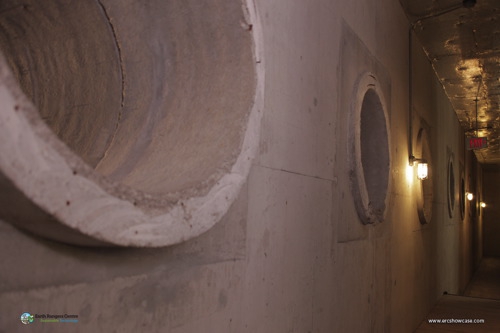
News
Residential
All about earth tubes: an energy-efficient way to heat/cool buildings
October 21, 2016 - Earth tubes are a new and viable way to reduce the amount of energy needed to heat and cool a building.
October 21, 2016 By Kyleigh Marcotte and Andrew Trudel
 Interior view of earth tubes and culvert at the Earth Rangers Centre
Interior view of earth tubes and culvert at the Earth Rangers Centre Researchers with Natural Resources Canada recently analyzed the effectiveness of earth tube heat exchanger systems. Considered a passive geothermal technology, earth tube exchangers enable the transfer of ground source energy to heat or cool a building while using its existing ventilation system. The goal of this project is to explore alternative ways to make commercial and residential buildings’ heating systems more energy efficient.
Earth tubes
Earth tubes are underground pipes buried beneath the frost line, the maximum depth within the soil where groundwater is expected to freeze. The frost line depth varies depending on the climatic conditions of a region.
Made of concrete, steel and/or plastic, earth tubes are used to condition outside ventilation air as it is pulled into a building. The surrounding earth moderates the temperature of the air drawn in through pipes, which is colder than the outdoor air in summer and warmer in the winter months. The air is then brought to ambient indoor temperatures by the building’s existing heating and cooling system.
“The addition of earth tubes to a building’s temperature control system could significantly reduce the need for certain kinds of ventilation air heating and cooling,” says Michel Tardif, research engineer and project leader with CanmetEnergy, a branch of Natural Resources Canada. In fact, results from a recent field study conducted in Toronto, Ont. indicated that earth tubes can warm winter air by as much as 14.3°C and cool summer air by about 6.8°C.
Other benefits of earth tubes
Energy efficiency is not the only advantage of using earth-to-air heat exchange systems such as earth tubes. They also require minimal maintenance and have lower operational costs than traditional temperature control systems. Additionally, they are effective in reducing the use of fossil fuels and the release of greenhouse gas emissions from buildings.
Earth tube guidelines
“We’re currently working to validate our research model with results from a building located on the Scarborough campus of the University of Toronto, which has one of the largest earth tube systems in Canada,” says Tardif. This research will lead to published design guidelines, since no well-defined parameters currently exist for earth tubes. These guidelines will help accelerate the adoption of earth tubes in buildings across the country.
Organizations across North America that are looking for new ways to improve the energy efficiency of their buildings and reduce operational costs have expressed an interest in the results of CanmetEnergy’s earth tubes research.
Earth tubes offer a sustainable alternative to reducing the use of conventional heating and cooling systems while producing clean, renewable, and affordable energy. Since building energy consumption accounts for about 15% of Canada’s greenhouse gas emissions, the more energy efficient buildings we have, the better it is for our environment.
Click HERE to see the original article.
Print this page


